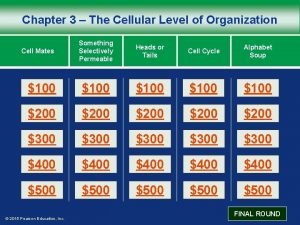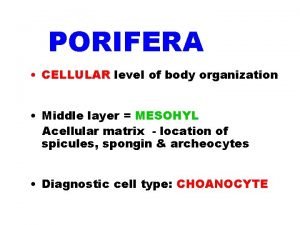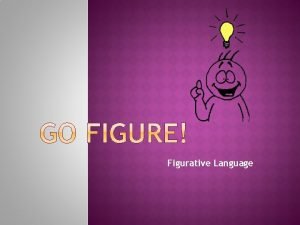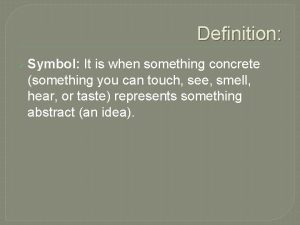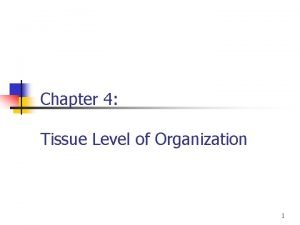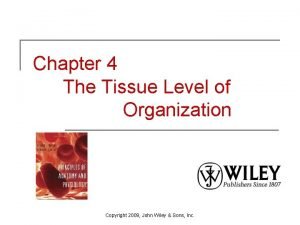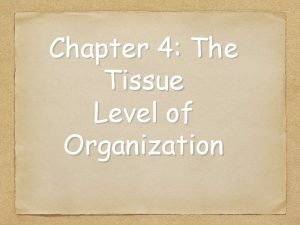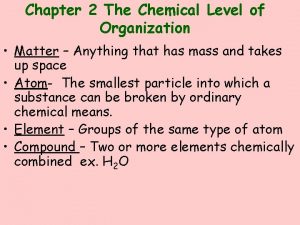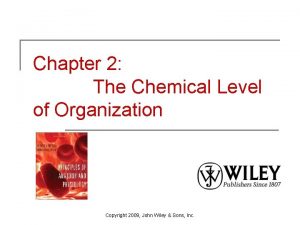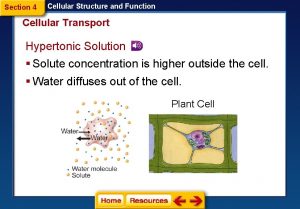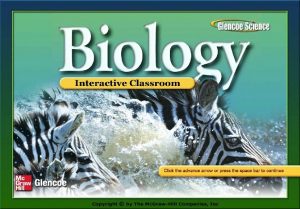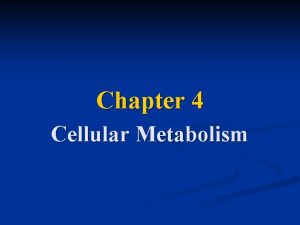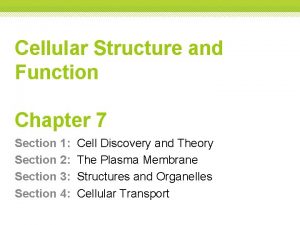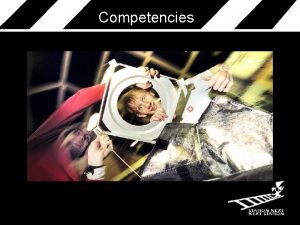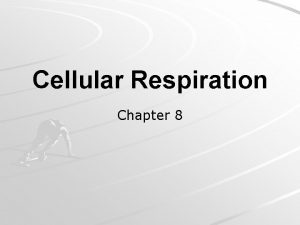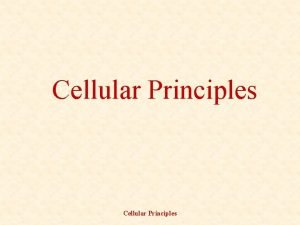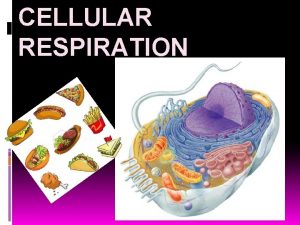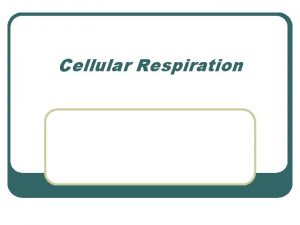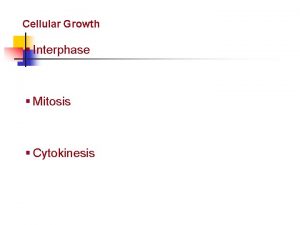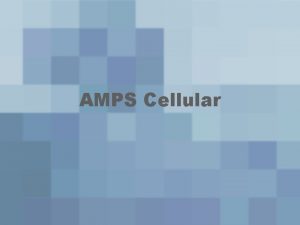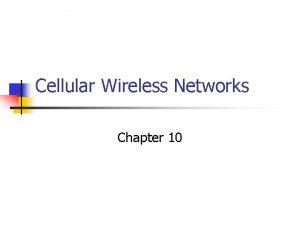Chapter 3 The Cellular Level of Organization Something





















































- Slides: 53

Chapter 3 – The Cellular Level of Organization Something Selectively Permeable Heads or Tails Cell Cycle Alphabet Soup $100 $100 $200 $200 $300 $300 $400 $400 $500 $500 Cell Mates © 2015 Pearson Education, Inc. FINAL ROUND

Topic 1: Cell Mates $100 Question What does the presence of many mitochondria imply about a cell’s energy requirements? a. It has a high demand for energy. b. It has a low demand for energy. c. There is a fluctuation in the energy needs, so flexibility is required. d. The number of mitochondria provides no ANSWER implication of energy needs. © 2015 Pearson Education, Inc. BACK TO GAME

Topic 1: Cell Mates $100 Answer What does the presence of many mitochondria imply about a cell’s energy requirements? a. It has a high demand for energy. b. It has a low demand for energy. c. There is a fluctuation in the energy needs, so flexibility is required. d. The number of mitochondria provides no implication of energy needs. © 2015 Pearson Education, Inc. BACK TO GAME

Topic 1: Cell Mates $200 Question Cells lining the small intestine have numerous fingerlike projections on their free surface that contain microvilli. What is the function of microvilli? a. to move substances across the cell’s surface b. to increase the cell’s surface area and absorptive ability c. to decrease the cell’s surface area and control filtration d. to increase constriction of the ANSWER intestinal lumen © 2015 Pearson Education, Inc. BACK TO GAME

Topic 1: Cell Mates $200 Answer Cells lining the small intestine have numerous fingerlike projections on their free surface that contain microvilli. What is the function of microvilli? a. to move substances across the cell’s surface b. to increase the cell’s surface area and absorptive ability c. to decrease the cell’s surface area and control filtration d. to increase constriction of the intestinal lumen © 2015 Pearson Education, Inc. BACK TO GAME

Topic 1: Cell Mates $300 Question Certain cells in the ovaries and testes contain large amounts of smooth endoplasmic reticulum (SER). Why? a. b. c. d. to produce large amounts of proteins to digest materials quickly to store large amounts of hormones to produce large amounts of steroid hormones © 2015 Pearson Education, Inc. ANSWER BACK TO GAME

Topic 1: Cell Mates $300 Answer Certain cells in the ovaries and testes contain large amounts of smooth endoplasmic reticulum (SER). Why? a. b. c. d. to produce large amounts of proteins to digest materials quickly to store large amounts of hormones to produce large amounts of steroid hormones © 2015 Pearson Education, Inc. BACK TO GAME

Topic 1: Cell Mates $400 Question Which of the listed organelles is non-membranous and correctly paired with its function? a. microvilli / movement of materials over cell’s surface b. ribosomes / protein synthesis c. mitochondria / produce ATP required by cell d. microtubules / increase surface area for absorption ANSWER © 2015 Pearson Education, Inc. BACK TO GAME

Topic 1: Cell Mates $400 Answer Which of the listed organelles is non-membranous and correctly paired with its function? a. microvilli / movement of materials over cell’s surface b. ribosomes / protein synthesis c. mitochondria / produce ATP required by cell d. microtubules / increase surface area for absorption © 2015 Pearson Education, Inc. BACK TO GAME

Topic 1: Cell Mates $500 Question Which statement correctly distinguishes between cytoplasm and cytosol? a. Cytosol has a higher concentration of suspended proteins than cytoplasm. b. Cytosol is the intracellular fluid and is composed of nutrients, ions, proteins, and wastes, and cytoplasm is the term for all material located between the cell membrane and nucleus. c. Potassium ion concentration is higher in cytoplasm than in cytosol. d. Cytosol and cytoplasm refer to the same substance. © 2015 Pearson Education, Inc. ANSWER BACK TO GAME

Topic 1: Cell Mates $500 Answer Which statement correctly distinguishes between cytoplasm and cytosol? a. Cytosol has a higher concentration of suspended proteins than cytoplasm. b. Cytosol is the intracellular fluid and is composed of nutrients, ions, proteins, and wastes, and cytoplasm is the term for all material located between the cell membrane and nucleus. c. Potassium ion concentration is higher in cytoplasm than in cytosol. d. Cytosol and cytoplasm refer to the same substance. © 2015 Pearson Education, Inc. BACK TO GAME

Topic 2: Something Selectively Permeable $100 Question Which component of the cell membrane is primarily responsible for the membrane’s ability to form a physical barrier between the cell’s internal and external environments? a. b. c. d. phospholipid bilayer glycocalyx peripheral proteins proteoglycans © 2015 Pearson Education, Inc. ANSWER BACK TO GAME

Topic 2: Something Selectively Permeable $100 Answer Which component of the cell membrane is primarily responsible for the membrane’s ability to form a physical barrier between the cell’s internal and external environments? a. b. c. d. phospholipid bilayer glycocalyx peripheral proteins proteoglycans © 2015 Pearson Education, Inc. BACK TO GAME

Topic 2: Something Selectively Permeable $200 Question Which transport process involves the movement of a substance down a concentration gradient, without using ATP and utilizing a carrier protein? a. b. c. d. facilitated diffusion osmosis active transport endocytosis ANSWER © 2015 Pearson Education, Inc. BACK TO GAME

Topic 2: Something Selectively Permeable $200 Answer Which transport process involves the movement of a substance down a concentration gradient, without using ATP and utilizing a carrier protein? a. b. c. d. facilitated diffusion osmosis active transport endocytosis © 2015 Pearson Education, Inc. BACK TO GAME

Topic 2: Something Selectively Permeable $300 Question Which pair of the following methods of carrier-mediated transport is paired with its function? a. active transport / it is dependent on a concentration gradient b. facilitated diffusion / substances are bound to a receptor and passed across the cell membrane by carrier proteins c. sodium–potassium pump / moves Na+ outside the cell and K+ inside the cell ANSWER d. both B and C © 2015 Pearson Education, Inc. BACK TO GAME

Topic 2: Something Selectively Permeable $300 Answer Which pair of the following methods of carrier-mediated transport is paired with its function? a. active transport / it is dependent on a concentration gradient b. facilitated diffusion / substances are bound to a receptor and passed across the cell membrane by carrier proteins c. sodium–potassium pump / moves Na+ outside the cell and K+ inside the cell d. both B and C © 2015 Pearson Education, Inc. BACK TO GAME

Topic 2: Something Selectively Permeable $400 Question What term below describes the cell membrane? a. b. c. d. semipermeable freely permeable impermeable nonpermeable ANSWER © 2015 Pearson Education, Inc. BACK TO GAME

Topic 2: Something Selectively Permeable $400 Answer What term below describes the cell membrane? a. b. c. d. semipermeable freely permeable impermeable nonpermeable © 2015 Pearson Education, Inc. BACK TO GAME

Topic 2: Something Selectively Permeable $500 Question Define “selectively permeable” as it applies to the cell membrane. a. It is a membrane through which nothing can pass. b. It is a membrane that allows the free passage of some molecules but restricts the passage of others. c. It is a membrane through which any substance can pass without restriction. d. It is a membrane that only allows ANSWER substances through by active transport. © 2015 Pearson Education, Inc. BACK TO GAME

Topic 2: Something Selectively Permeable $500 Answer Define “selectively permeable” as it applies to the cell membrane. a. It is a membrane through which nothing can pass. b. It is a membrane that allows the free passage of some molecules but restricts the passage of others. c. It is a membrane through which any substance can pass without restriction. d. It is a membrane that only allows substances through by active transport. © 2015 Pearson Education, Inc. BACK TO GAME

Topic 3: Heads or Tails $100 Question Which type of integral protein allows water and small ions to pass through the cell membrane? a. b. c. d. receptor proteins carrier proteins channel proteins recognition proteins ANSWER © 2015 Pearson Education, Inc. BACK TO GAME

Topic 3: Heads or Tails $100 Answer Which type of integral protein allows water and small ions to pass through the cell membrane? a. b. c. d. receptor proteins carrier proteins channel proteins recognition proteins © 2015 Pearson Education, Inc. BACK TO GAME

Topic 3: Heads or Tails $200 Question If the cell membrane were freely permeable to sodium ions (Na+), how would the transmembrane potential be affected? a. b. c. d. It would not change. It would become more positive. It would become more negative. It would become unstable. ANSWER © 2015 Pearson Education, Inc. BACK TO GAME

Topic 3: Heads or Tails $200 Answer If the cell membrane were freely permeable to sodium ions (Na+), how would the transmembrane potential be affected? a. b. c. d. It would not change. It would become more positive. It would become more negative. It would become unstable. © 2015 Pearson Education, Inc. BACK TO GAME

Topic 3: Heads or Tails $300 Question Which of the following is NOT a function of membrane proteins? a. b. c. d. to bind specific ligands to anchor or stabilize the cell membrane to produce energy for the cell to regulate ion passage ANSWER © 2015 Pearson Education, Inc. BACK TO GAME

Topic 3: Heads or Tails $300 Answer Which of the following is NOT a function of membrane proteins? a. b. c. d. to bind specific ligands to anchor or stabilize the cell membrane to produce energy for the cell to regulate ion passage © 2015 Pearson Education, Inc. BACK TO GAME

Topic 3: Heads or Tails $400 Question Some pediatricians recommend the use of a 10 percent salt solution to relieve congestion for infants with stuffy noses. What effect would such a solution have on the cells lining the nasal cavity, and why? a. b. c. d. Cells will lose water because this is a hypertonic solution. Cells will lose water because this is a hypotonic solution. Cells will gain water because this is a hypertonic solution. Cells will gain water because this is a hypotonic solution. ANSWER © 2015 Pearson Education, Inc. BACK TO GAME

Topic 3: Heads or Tails $400 Answer Some pediatricians recommend the use of a 10 percent salt solution to relieve congestion for infants with stuffy noses. What effect would such a solution have on the cells lining the nasal cavity, and why? a. b. c. d. Cells will lose water because this is a hypertonic solution. Cells will lose water because this is a hypotonic solution. Cells will gain water because this is a hypertonic solution. Cells will gain water because this is a hypotonic solution. © 2015 Pearson Education, Inc. BACK TO GAME

Topic 3: Heads or Tails $500 Question How would a decrease in the concentration of oxygen in the lungs affect the diffusion of oxygen into the blood? a. A decrease in molecule size results in decreased diffusion. b. A decrease in distance results in increased diffusion. c. An increase in electrical forces results in increased diffusion. d. A decrease in gradient size results in decreased speed of diffusion. ANSWER © 2015 Pearson Education, Inc. BACK TO GAME

Topic 3: Heads or Tails $500 Answer How would a decrease in the concentration of oxygen in the lungs affect the diffusion of oxygen into the blood? a. A decrease in molecule size results in decreased diffusion. b. A decrease in distance results in increased diffusion. c. An increase in electrical forces results in increased diffusion. d. A decrease in gradient size results in decreased speed of diffusion. © 2015 Pearson Education, Inc. BACK TO GAME

Topic 4: Cell Cycle $100 Question During gene activation, histones are a. b. c. d. synthesized wrapped with DNA strands temporarily removed hydrolyzed ANSWER © 2015 Pearson Education, Inc. BACK TO GAME

Topic 4: Cell Cycle $100 Answer During gene activation, histones are a. b. c. d. synthesized wrapped with DNA strands temporarily removed hydrolyzed © 2015 Pearson Education, Inc. BACK TO GAME

Topic 4: Cell Cycle $200 Question Cancer may result after mutations in a. b. c. d. genes regulating cell growth genes regulating differentiation genes regulating cell division all of the above ANSWER © 2015 Pearson Education, Inc. BACK TO GAME

Topic 4: Cell Cycle $200 Answer Cancer may result after mutations in a. b. c. d. genes regulating cell growth genes regulating differentiation genes regulating cell division all of the above © 2015 Pearson Education, Inc. BACK TO GAME

Topic 4: Cell Cycle $300 Question As cells age, what part of a chromosome shortens, eventually signaling the end of cell division? a. b. c. d. centromere telomere kinetochore supercoiled regions near the centromere ANSWER © 2015 Pearson Education, Inc. BACK TO GAME

Topic 4: Cell Cycle $300 Answer As cells age, what part of a chromosome shortens, eventually signaling the end of cell division? a. b. c. d. centromere telomere kinetochore supercoiled regions near the centromere © 2015 Pearson Education, Inc. BACK TO GAME

Topic 4: Cell Cycle $400 Question During DNA replication, a nucleotide is deleted from a sequence that normally codes for a polypeptide. What effect will this deletion have on the amino acid sequence of the polypeptide? a. b. c. d. No effect, deletion will be skipped. No effect, deletion will be automatically repaired. Amino acid sequence will disintegrate. Amino acid sequence would be ANSWER altered. © 2015 Pearson Education, Inc. BACK TO GAME

Topic 4: Cell Cycle $400 Answer During DNA replication, a nucleotide is deleted from a sequence that normally codes for a polypeptide. What effect will this deletion have on the amino acid sequence of the polypeptide? a. b. c. d. No effect, deletion will be skipped. No effect, deletion will be automatically repaired. Amino acid sequence will disintegrate. Amino acid sequence would be altered. © 2015 Pearson Education, Inc. BACK TO GAME

Topic 4: Cell Cycle $500 Question Which of the following stages of mitosis is correctly paired with the events of that stage? a. anaphase / centromeres of chromatid pairs separate and daughter chromosomes are pulled to opposite ends of the cell b. prophase / chromatids are aligned along center of the cell c. telophase / chromosomes condense and nuclear membrane fragments ANSWER d. all of the above © 2015 Pearson Education, Inc. BACK TO GAME

Topic 4: Cell Cycle $500 Answer Which of the following stages of mitosis is correctly paired with the events of that stage? a. anaphase / centromeres of chromatid pairs separate and daughter chromosomes are pulled to opposite ends of the cell b. prophase / chromatids are aligned along center of the cell c. telophase / chromosomes condense and nuclear membrane fragments d. all of the above © 2015 Pearson Education, Inc. BACK TO GAME

Topic 5: Alphabet Soup $100 Question Germ cells are also known as a. b. c. d. somatic cells sex cells liver cells white blood cells ANSWER © 2015 Pearson Education, Inc. BACK TO GAME

Topic 5: Alphabet Soup $100 Answer Germ cells are also known as a. b. c. d. somatic cells sex cells liver cells white blood cells © 2015 Pearson Education, Inc. BACK TO GAME

Topic 5: Alphabet Soup $200 Question Parkinson’s disease is a neurodegenerative disease characterized by the loss of what type of neuron? a. b. c. d. sensory motor dopamine-producing photoreceptors ANSWER © 2015 Pearson Education, Inc. BACK TO GAME

Topic 5: Alphabet Soup $200 Answer Parkinson’s disease is a neurodegenerative disease characterized by the loss of what type of neuron? a. b. c. d. sensory motor dopamine-producing photoreceptors © 2015 Pearson Education, Inc. BACK TO GAME

Topic 5: Alphabet Soup $300 Question What process would be affected by the lack of the enzyme RNA polymerase? a. Nothing would be affected; DNA polymerase would take over. b. It would affect the cell’s ability to duplicate DNA. c. It would affect the cell’s ability to translate DNA. d. It would affect the cell’s ability to transcribe DNA. ANSWER © 2015 Pearson Education, Inc. BACK TO GAME

Topic 5: Alphabet Soup $300 Answer What process would be affected by the lack of the enzyme RNA polymerase? a. Nothing would be affected; DNA polymerase would take over. b. It would affect the cell’s ability to duplicate DNA. c. It would affect the cell’s ability to translate DNA. d. It would affect the cell’s ability to transcribe DNA. © 2015 Pearson Education, Inc. BACK TO GAME

Topic 5: Alphabet Soup $400 Question What is the genetic code? a. It is the method by which proteins code for amino acids. b. It is the “language” the cell uses in the form of triplet codons, which specify individual amino acids. c. It is the portion of DNA that contains instructions for the synthesis of t. RNA. d. It is the strand of DNA containing complementary triplets used for m. RNA production. ANSWER © 2015 Pearson Education, Inc. BACK TO GAME

Topic 5: Alphabet Soup $400 Answer What is the genetic code? a. It is the method by which proteins code for amino acids. b. It is the “language” the cell uses in the form of triplet codons, which specify individual amino acids. c. It is the portion of DNA that contains instructions for the synthesis of t. RNA. d. It is the strand of DNA containing complementary triplets used for m. RNA production. © 2015 Pearson Education, Inc. BACK TO GAME

Topic 5: Alphabet Soup $500 Question What are two reasons that m. RNA transcription is so vital? a. b. c. d. Protein synthesis occurs through transcription, and it occurs in the nucleus to maintain homeostasis. DNA cannot leave the nucleus / transcription ensures that m. RNA exactly matches the coding strand of the gene. It allows formation of chains of amino acids / the same information is presented in a different language. None of these answers are correct. ANSWER © 2015 Pearson Education, Inc. BACK TO GAME

Topic 5: Alphabet Soup $500 Answer What are two reasons that m. RNA transcription is so vital? a. Protein synthesis occurs through transcription, and it occurs in the nucleus to maintain homeostasis. b. DNA cannot leave the nucleus / transcription ensures that m. RNA exactly matches the coding strand of the gene. c. It allows formation of chains of amino acids / the same information is presented in a different language. d. None of these answers are correct. © 2015 Pearson Education, Inc. BACK TO GAME

FINAL ROUND Question What is so special about osmosis, compared with diffusion? a. Osmosis allows free passage of alcohol, fatty acids, and steroids through the plasma membrane. b. Osmosis is the movement of water rather than solute. c. In osmosis, water flows across a membrane toward the solution that has a higher concentration of solutes, because that is where water concentration ANSWER is lower. BACK TO GAME d. B and C are correct. © 2015 Pearson Education, Inc.

FINAL ROUND Answer What is so special about osmosis, compared with diffusion? a. Osmosis allows free passage of alcohol, fatty acids, and steroids through the plasma membrane. b. Osmosis is the movement of water rather than solute. c. In osmosis, water flows across a membrane toward the solution that has a higher concentration of solutes, because that is where water concentration is lower. BACK TO GAME d. B and C are correct. © 2015 Pearson Education, Inc.
 Chapter 3 the cellular level of organization
Chapter 3 the cellular level of organization Porifera cellular organization
Porifera cellular organization Molecular level vs cellular level
Molecular level vs cellular level With symbolism, authors use concrete objects to represent
With symbolism, authors use concrete objects to represent When something works
When something works Smart is something you become not something you are
Smart is something you become not something you are Open oven
Open oven Something concrete that stands for something abstract
Something concrete that stands for something abstract Symbol/symbolism definition
Symbol/symbolism definition Something old something new poem
Something old something new poem Adjective language feature
Adjective language feature Chapter 4 the tissue level of organization
Chapter 4 the tissue level of organization Chapter 4 the tissue level of organization
Chapter 4 the tissue level of organization Chapter 4 the tissue level of organization
Chapter 4 the tissue level of organization The chemical level of organization
The chemical level of organization The chemical level of organization chapter 2
The chemical level of organization chapter 2 To level something
To level something Process organization in computer organization
Process organization in computer organization Compare and contrast organization
Compare and contrast organization Chapter 9 section 1 cellular growth
Chapter 9 section 1 cellular growth Chapter 8 section 3 cellular respiration
Chapter 8 section 3 cellular respiration Chapter 8 lesson 1 life is cellular
Chapter 8 lesson 1 life is cellular Section 4 cellular transport answer key
Section 4 cellular transport answer key Chapter 9 cellular reproduction answer key
Chapter 9 cellular reproduction answer key Endocytosis moves materials _____ a cell via ____
Endocytosis moves materials _____ a cell via ____ Chapter 4 cellular metabolism
Chapter 4 cellular metabolism Chapter 7 section 1 cell discovery and theory
Chapter 7 section 1 cell discovery and theory Chapter 9: cellular respiration: harvesting chemical energy
Chapter 9: cellular respiration: harvesting chemical energy Chapter 9 cellular respiration harvesting chemical energy
Chapter 9 cellular respiration harvesting chemical energy Chapter 9: cellular respiration: harvesting chemical energy
Chapter 9: cellular respiration: harvesting chemical energy Chapter 9 cellular reproduction
Chapter 9 cellular reproduction Chapter 8 cellular reproduction cells from cells
Chapter 8 cellular reproduction cells from cells Hình ảnh bộ gõ cơ thể búng tay
Hình ảnh bộ gõ cơ thể búng tay Frameset trong html5
Frameset trong html5 Bổ thể
Bổ thể Tỉ lệ cơ thể trẻ em
Tỉ lệ cơ thể trẻ em Gấu đi như thế nào
Gấu đi như thế nào Glasgow thang điểm
Glasgow thang điểm Alleluia hat len nguoi oi
Alleluia hat len nguoi oi Kể tên các môn thể thao
Kể tên các môn thể thao Thế nào là hệ số cao nhất
Thế nào là hệ số cao nhất Các châu lục và đại dương trên thế giới
Các châu lục và đại dương trên thế giới Công thức tính độ biến thiên đông lượng
Công thức tính độ biến thiên đông lượng Trời xanh đây là của chúng ta thể thơ
Trời xanh đây là của chúng ta thể thơ Mật thư tọa độ 5x5
Mật thư tọa độ 5x5 101012 bằng
101012 bằng độ dài liên kết
độ dài liên kết Các châu lục và đại dương trên thế giới
Các châu lục và đại dương trên thế giới Thơ thất ngôn tứ tuyệt đường luật
Thơ thất ngôn tứ tuyệt đường luật Quá trình desamine hóa có thể tạo ra
Quá trình desamine hóa có thể tạo ra Một số thể thơ truyền thống
Một số thể thơ truyền thống Cái miệng nó xinh thế chỉ nói điều hay thôi
Cái miệng nó xinh thế chỉ nói điều hay thôi Vẽ hình chiếu vuông góc của vật thể sau
Vẽ hình chiếu vuông góc của vật thể sau Thế nào là sự mỏi cơ
Thế nào là sự mỏi cơ
